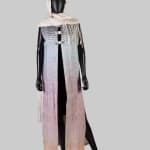Margaret Roach Wheeler
Rapt Dawn - The Crane
With headdress created by Maria Mayo
Fabric construction by Alice McKee
Hand-dyed silk
Fabric construction by Alice McKee
Hand-dyed silk
Copyright The Artist
Further images
-
(View a larger image of thumbnail 1
)

-
(View a larger image of thumbnail 2
)

-
(View a larger image of thumbnail 3
)

-
(View a larger image of thumbnail 4
)

-
(View a larger image of thumbnail 5
)

-
(View a larger image of thumbnail 6
)

-
(View a larger image of thumbnail 7
)

-
(View a larger image of thumbnail 8
)

-
(View a larger image of thumbnail 9
)

Wheeler hand-dyed silk yarn from Bhutan gifted to her by a friend so that the colors simulate the break of dawn—with yellows at the base and darker shades on the...
Wheeler hand-dyed silk yarn from Bhutan gifted to her by a friend so that the colors simulate the break of dawn—with yellows at the base and darker shades on the shoulders to represent the night sky. It is inspired by an early morning walk she took up a hill when she lived in Joplin, Oklahoma. “I watched the dawn coming up and thought of the dawn of a new era,” Wheeler recalls.
Wheeler designed and wove the fabric for the headdress, with the silversmithed crane on the headdress by Maria Mayo and the fabric construction by Mayo’s daughter, Alice McKee. The crane serves as a symbol for the migration of the ancestors of Native Americans, believed to have crossed on the Bering Land Bridge from Asia to the Americas. Sandhill cranes cross the Bering Strait during their migrations between North America and Eurasia.
Wheeler designed and wove the fabric for the headdress, with the silversmithed crane on the headdress by Maria Mayo and the fabric construction by Mayo’s daughter, Alice McKee. The crane serves as a symbol for the migration of the ancestors of Native Americans, believed to have crossed on the Bering Land Bridge from Asia to the Americas. Sandhill cranes cross the Bering Strait during their migrations between North America and Eurasia.








